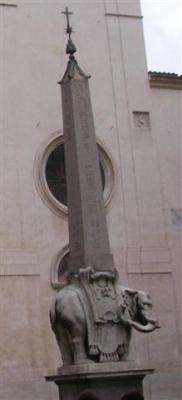This morning it was bitter cold, overcast, and windy, with on and off rain. We debated going into Rome, kind of afraid to leave Kosmos in the heavy wind. We decided we were being paranoid, though, and went.
The first thing on today’s list of sites to see was the Pantheon. We exited the Colosseum Metro station to see our connecting bus leaving. Darn. It was really cold and had started raining again, so we took shelter in a nearby café for some hot food and beverages to warm us up. After lunch, we caught a bus that dropped us a few blocks away from the Pantheon. Fortunately, we didn’t have to stand in the rain long.
On the walk over, we passed a statue of an obelisk strapped to the back of an elephant, quite similar to the one that we had seen in Catania. We are pretty sure that the obelisk in Catania isn’t a real Egyptian artifact. It just didn’t have that real Egyptian look to it. However, in passing by this statue, it was immediately evident to us that the obelisk had been pilfered from Thebes (Luxor), Egypt. It is made of the marble that is dominant in most of the temples in Thebes we saw, and it is inscribed with hieroglyphics, looking incredibly similar to the obelisks we had seen in Thebes. We checked Lonely Planet, and, sure enough, it is a real Egyptian obelisk dating from the 6th century BC. The statue was designed by famed sculptor Bernini.

We can’t remember if Continue reading
